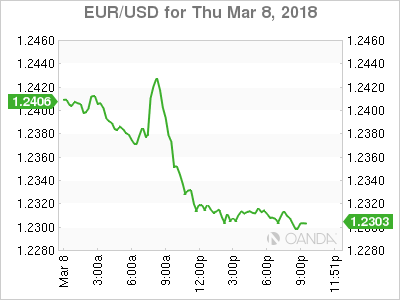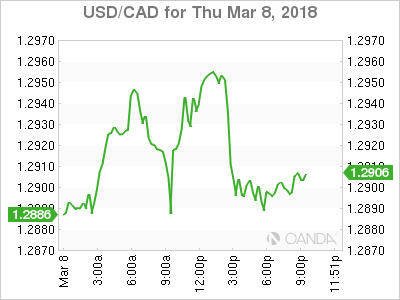The USD was higher on Thursday after the European Central Bank (ECB) published a hawkish statement but was neutralized by the central bank’s President Mario Draghi who remains concerned about low inflation and the rise of protectionism. The steel and aluminium tariffs announced last week have threatened to start a trade war and despite the US President’s unfazed demeanour it could end up costing the US thousands of jobs. Employment data will be the focus of the market on Friday as the U.S. non farm payrolls (NFP) report will be released at 8:30 am EST with US worker wages garnering the most attention as inflationary signals..
- US expected to add 200,000 jobs in February
- Canadian jobs to bounce from January drop
- US wage growth forecasted at 0.2 percent
Dollar Higher After ECB Awaiting US Jobs Report
The EUR/USD lost 0.81 percent on Thursday. The single currency is trading at 1.2310 as investors sold some positions after the European Central Bank (ECB) published its rate statement. The central bank kept rates unchanged but did remove mention of adding more stimulus if the economy needed it. ECB President Mario Draghi was neutral with his comments as he praised rising European growth but also mentioned slow inflation and trade challenges ahead. The EUR gained on the statement but Draghi made sure to bring the currency back to reality as inflation and trade are in focus. The promised tariffs by the Trump Administration are yet to materialize but it is not hard to expect this is the last time they will be used to protect American manufacturers.
The world appears to be moving without the US as evidenced by the signing of the Trans Pacific Pact (TPP) on Thursday by the 11 remaining nations. The US steel and aluminium tariffs have already cost Trump the backing of economic advisor Gary Cohn who resigned this week after failing to convict the White House from sounding the tariff horn. Draghi during his press conference used the tariffs as an example of the dangers in unilateral decisions, specially when aimed at your allies.
The market is pricing in a rate hike in two weeks by the U.S. Federal Reserve. The CME FedWatch tool shows a probability of 86 percent that central bank will lift interest rates by 25 basis points, those odds are up from 76.1 percent a month ago. The dollar has not been able to capitalize of strong growth expectations and a tightening policy by the American central bank as concerns have risen on the twin deficits, but also on what will happen after rates hit the 3 percent target.
The USD/CAD lost 0.10 percent in the last 24 hours. The currency pair is trading at 1.2897 in a volatile day of trading for the loonie. The Canadian currency depreciated during the Asian session and traded near 1.2950 only to appreciated below 1.29 only to once again rise ahead of US data. The final trend in the session came courtesy of a report outlining that the steel and aluminium tariffs will begin in 15 days, but that Canada and Mexico are exempt. The exemption is a CAD positive as it could also mean NAFTA will remain as the White House is taking into consideration the benefits of the trade deal. Canadian NAFTA negotiators were floored by the proposed US tariffs but it appears the US has backed down as both Mexico and Canada commented they were prepared to retaliate if they were not excluded.
The CAD has had a horrible start to 2018 and is down 2.51 percent against the USD as the uncertainty of the fate of NAFTA lingers with the 8th and final round to take place at the end of the month. The Canadian economy is slowing down, which in turn will make it less likely the Bank of Canada (BoC) keeps pace with the Fed’s rate hike path
The Federal Reserve is widely expected to raise rate four times in 2018, but the Bank of Canada will likely be unable to compete with that kind of pace. The BoC is concerned with economic growth, which slowed in the fourth quarter, as well as uncertainty over NAFTA, which could fall apart if the Trump administration makes good on its threat to withdraw if its demands for more favorable treatment for US goods is not met. The Bank is not expected to raise rates before May, and if the Fed outpaces the BoC on the rate front, the Canadian dollar could lose ground to a more attractive US currency.
Canadian jobs will look to bounce back form the worst drop in nine years. Statistics Canada will release the employment change data on Friday, March 9 at 8:30 am EST. The Canadian economy is expected to add close to 22,000 jobs after January’s debacle where it lost 88,000. The jobs data in Canada will share release time with the NFP that will be more heavily scrutinized by the market with an eye for higher inflation signals in the US.
Market events to watch this week:
Thursday, March 8
Midnight JPY BOJ Policy Rate
Midnight JPY Monetary Policy Statement
Friday, March 9
JPY BOJ Press Conference
4:30am GBP
Manufacturing Production m/m
8:30am CAD Employment Change
8:30am USD Average Hourly Earnings m/m
8:30am USD Non-Farm Employment Change
















